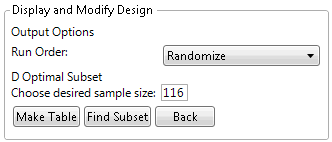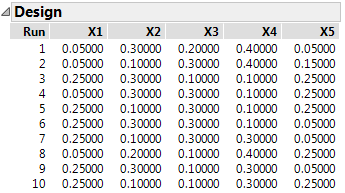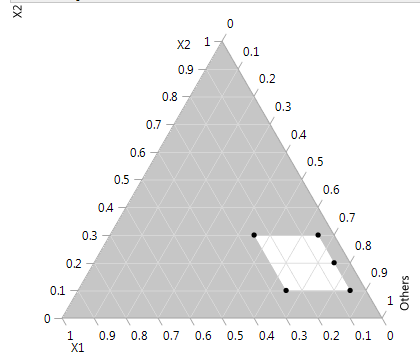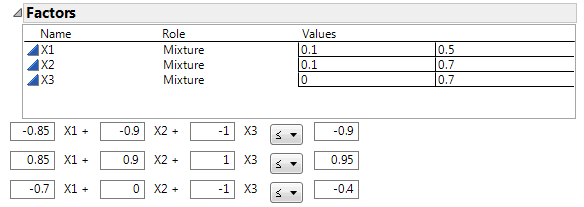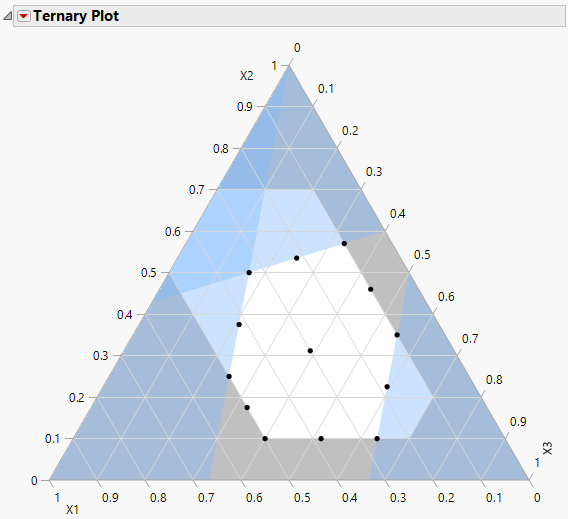|
1.
|
Select DOE > Classical > Mixture Design.
|
|
3.
|
Figure 12.12 Ranges for Five-factors
|
4.
|
|
6.
|
Note: The Find Subset option uses the row exchange method (not coordinate exchange) to find the optimal subset of rows.
Figure 12.14 Ten Run D-optimal Extreme Vertices Design
|
7.
|
Click Make Table.
|
|
8.
|
From the design table, select Graph >Ternary Plot.
|
|
9.
|
When you have more than three mixture components, the ternary plot shows a series of plots. Each plot has two component axes and the third axis is the sum of all other components. The plots are shaded if you have a constrained region. The unshaded portion represents the feasible region. For details about ternary plots see Ternary Plot Overview.
Consider the classic example presented by Snee (1979) and Piepel (1988). This example has three factors, X1, X2, and X3, with factor bounds and three linear constraints.
|
1.
|
Select DOE > Classical > Mixture Design.
|
|
2.
|
|
3.
|
|
4.
|
Click the Extreme Vertices button.
|
|
5.
|
Click Make Table.
|
|
6.
|
From the design table, select Graph >Ternary Plot.
|
|
7.
|
Figure 12.17 Ternary Plot Showing Piepel Example with Constraints
The ternary plot shows the feasible region as defined by the factor limits and the linear constraints. The design points are at the six vertices of the feasible region, at the six edge mid-points, and the overall centroid. For details about ternary plots see Ternary Plot Overview.
If there are linear constraints, JMP uses the CONSIM algorithm developed by R.E. Wheeler, described in Snee (1979) and presented by Piepel (1988) as CONVRT. The method is also described in Cornell (1990, Appendix 10a). The method combines constraints and checks to see whether vertices violate them. If so, it drops the vertices and calculates new ones. The method named CONAEV for doing centroid points is by Piepel (1988).
If there are no linear constraints (only range constraints), the extreme vertices design is constructed using the XVERT method developed by Snee and Marquardt (1974) and Snee (1975). After the vertices are found, a simplex centroid method generates combinations of vertices up to a specified order.
The XVERT method first creates a full 2nf – 1 design using the given low and high values of the nf – 1 factors with smallest range. Then, it computes the value of the one factor left out based on the restriction that the factors’ values must sum to one. It keeps points that are not in factor’s range. If not, it increments or decrements the value to bring it within range, and decrements or increments each of the other factors in turn by the same amount. This method keeps the points that still satisfy the initial restrictions.
The above algorithm creates the vertices of the feasible region in the simplex defined by the factor constraints. However, Snee (1975) has shown that it can also be useful to have the centroids of the edges and faces of the feasible region. A generalized n-dimensional face of the feasible region is defined by nf – n of the boundaries and the centroid of a face defined to be the average of the vertices lying on it. The algorithm generates all possible combinations of the boundary conditions and then averages over the vertices generated on the first step.

